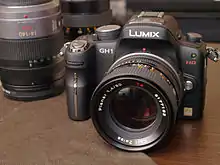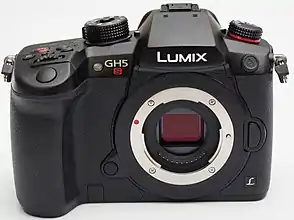Lumix
Lumix ist der Markenname für die Digitalkameras der Panasonic Corporation. Das Produktspektrum reicht von Kompaktkameras über Bridgekameras zu System- und Spiegelreflexkameras.
| Lumix | |
|---|---|
 Logo | |
| Rechtsform | Joint Venture zwischen Panasonic Corporation und Leica Camera |
| Sitz | Kadoma (Osaka), Japan |
| Branche | Unterhaltungselektronik |
| Website | www.panasonic.com/global/consumer/lumix/ |
Zusammenarbeit mit Leica
Seit 2001 sind viele Lumix-Kameras mit Objektiven von Leica ausgestattet.[1] Diese Objektive werden im Rahmen einer Kooperationsvereinbarung zwischen Panasonic und Leica in Deutschland entwickelt und in Japan hergestellt. Einige Lumix-Kameras gibt es auch in nahezu baugleicher Form von Leica zu kaufen.
Modelllinien








Kompaktkameras
- FP
- Sehr kompakte Kleinkamera mit „gefalteter Optik“, d. h., das Objektiv fährt nicht aus dem Gehäuse, sondern ist im Inneren untergebracht.
- FS
- Als FH in Nordamerika.
- Kompakte Mittelklasse.
- FX / LF
- Kompakte Oberklasse.
- Lumix LX
- Premium-Kompaktkameras, bei denen Einschränkungen bei Zoombereich und Pixel-Zahl in Kauf genommen werden, um eine bessere Bildqualität und höhere Lichtstärke zu erzielen. Diese hochpreisigen Modelle gibt es auch von Leica (Serie Leica D-Lux).
- ZX
- Als ZR in Nordamerika.
- Verkleinerte Variante der TZ-Linie mit 8-fachem Zoomobjektiv.
Kompakt Standard
- LS
- Preisgünstigste Linie. Arbeitet mit Mignon-Batterien, um teurere Akkus einzusparen.
- LZ
- Standardklasse, eine Stufe hochwertiger als LS.
Tough Outdoor
- FT
- Als TS in Nordamerika.
- Wasserdichte, schlagfeste und staubsichere Kompaktkameras.
Superzoom
- Lumix FZ
- Mittelgroße Bridgekameras mit großem Zoombereich.
- Lumix TZ (Lumix ZS in Nordamerika)
- Kompakte Reisekameras mit einem 10- bis 30-fachen Zoomobjektiv (Traveller Zoom).
- SZ
- Schlanke Superzoom-Kameras mit Weitwinkel (Stylish Zoom).
- Bislang mit den Modellen SZ1, SZ3, SZ7, SZ8 und SZ10 (Juli 2015).
Kameragehäuse
Micro-Four-Thirds-System (ohne Spiegel):
- G: Kameragehäuse mit elektronischem Sucher (siehe Panasonic-Lumix-DMC-G-Reihe)
- GF: Kameragehäuse ohne Sucher
- GH: Kameragehäuse mit hochwertiger Videofunktion (zum Beispiel Panasonic Lumix DMC-GH4)
- GX: kompakte, design-orientierte Kameragehäuse (zum Beispiel Panasonic Lumix DMC-GX8)
Objektive
- G
- G Macro (Nahaufnahmeobjektive)
- G Vario (Zoomobjektive)
- G X Vario (hochwertige Zoomobjektive)
- Leica DG
Spiegelreflexsysteme der Baureihe L
- Four-Thirds Spiegelreflexkameras
Modellübersicht (Auswahl)

| Modell | Zoom | Brennweite (35-mm-Äquivalent) | Lichtstärke (Weitwinkel bis Tele) | Sensor | Prozessor | Größe (B × H × T) | Marktpreis |
|---|---|---|---|---|---|---|---|
| DMC-FS10 | 5× | 28–140 mm | f/2,8–6,9 | 1/2,33", 12,1 Megapixel | Venus IV | 98,0 × 55,0 × 23,0 mm | 179 Euro (Juli 2009) |
| DMC-FS15 | 5× | 29–145 mm | f/3,3–5,9 | 1/2,33", 12,7 Megapixel | Venus IV | 97,0 × 54,4 × 21,7 mm | 195 Euro (Januar 2009) |
| DMC-FS16 | 4× | 28–112 mm | f/3,1–6,5 | 1/2,33", 14,1 Megapixel | 94 × 54 × 19 mm | 179 Euro (Juni 2012) | |
| DMC-FS20 | 4× | 30–120 mm | f/3,3–5,8 | 1/2,33", 10,7 Megapixel | Venus IV | 94,9 × 57,1 × 22,9 mm | 170 Euro (Dezember 2008) |
| DMC-FS25 | 5× | 29–145 mm | f/3,3–5,9 | 1/2,33", 12,7 Megapixel | Venus IV | 97,0 × 57,9 × 21,8 mm | Im Februar 2009 noch nicht erhältlich |
| DMC-FS3 | 3× | 33–100 mm | f/2,8–5,1 | 1/2,5", 8,32 Megapixel | Venus IV | 94,9 × 53,4 × 22,5 mm | 100 Euro (Dezember 2008) |
| DMC-FS5 | 4× | 30–120 mm | f/3,3–5,8 | 1/2,33", 10,7 Megapixel | Venus IV | 94,9 × 53,4 × 22,5 mm | 140 Euro (Dezember 2008) |
| DMC-FS6 | 4× | 33–132 mm | f/2,8–5,9 | 1/2,5", 8,32 Megapixel | Venus IV | 97,0 × 54,4 × 21,2 mm | 145 Euro (Januar 2009) |
| DMC-FS7 | 4× | 33–132 mm | f/2,8–5,9 | 1/2,5", 10,35 Megapixel | Venus IV | 97,0 × 54,4 × 21,7 mm | 170 Euro (Januar 2009) |
| DMC-FT1 (DMC-TS1) | 4,6× | 28–128 mm | f/3,3–5,9 | 1/2,33", 12,7 Megapixel | Venus HD | 98,3 × 63,1 × 23,0 mm | 290 Euro (September 2009) |
| DMC-FT10 | 4× | 35–140 mm | f/3,3-5,9 | 1/2,33", 14,1 Megapixel | Venus IV | 100 × 64 × 22 mm | 190 Euro (März 2011) |
| DMC-FT2 (DMC-TS2) | 4,6× | 28–128 mm | f/3,3-5,9 | 1/2,33", 14,1 Megapixel | Venus HD II | 101 × 64 × 27 mm | 310 Euro (September 2010) |
| DMC-FT3 (DMC-TS3) | 4,6× | 28–128 mm | f/3,3-5,9 | 1/2,33", 12,1 Megapixel | Venus FHD | 104 × 64 × 27 mm | 330 Euro (August 2011) |
| DMC-FX01 | 3,6× | 28–102 mm | f/2,8–5,6 | 1/2,5", 6,37 Megapixel | Venus Plus | 94 × 51 × 24 mm | 279 Euro (April 2006) |
| DMC-FX150 | 3,6× | 28–100 mm | f/2,8–5,6 | 1/1,72", 14,0 Megapixel | Venus IV | 96,7 × 54,0 × 24,8 mm | 250 Euro (Dezember 2008) |
| DMC-FX37 | 5× | 25–125 mm | f/2,8–5,9 | 1/2,33", 10,7 Megapixel | Venus IV | 94,7 × 51,9 × 22,0 mm | 210 Euro (Dezember 2008) |
| DMC-FX40 (DMC-FX48) | 5× | 25–125 mm | f/2,8–5,9 | 1/2,33", 12,7 Megapixel | Venus V | 95,3 × 52,9 × 21,5 mm | Im Februar 2009 noch nicht erhältlich |
| DMC-FX500 | 5× | 25–125 mm | f/2,8–5,9 | 1/2,33", 10,7 Megapixel | Venus IV | 94,9 × 57,1 × 22,9 mm | 230 Euro (Dezember 2008) |
| DMC-FX550 (DMC-FX580) | 5× | 25–125 mm | f/2,8–5,9 | 1/2,33", 12,7 Megapixel | Venus V | 94,9 × 57,1 × 21,9 mm | Im Februar 2009 noch nicht erhältlich |
| DMC-FZ1 | 12× | 35–420 mm | f/2,8 | 1/3,2", 2,1 Megapixel | 125 × 70 × 83 mm | ||
| DMC-FZ2 | 12× | 35–420 mm | f/2,8 | 1/3,2", 2,1 Megapixel | 114 × 70 × 83 mm | ||
| DMC-FZ7 | 12× | 36–432 mm | f/2,8–3,3 | 1/2,5", 6,37 Megapixel | 113 × 72 × 79 mm | ||
| DMC-FZ8 | 12× | 36–432 mm | f/2,8–3,3 | 1/2,5", 7,38 Megapixel | Venus III | 112,5 × 72,2 × 79,0 mm | 300 Euro (2008) |
| DMC-FZ27 | 12× | 5,95 Megapixel | 112 × 72 × 79 mm | ||||
| DMC-FZ10 | 12× | 35–420 mm | f/2,8 | 1/2,5", 4,0 Megapixel | 139 × 87 × 106 mm | ||
| DMC-FZ20 | 12× | 36–432 mm | f/2,8 | 1/2,5", 5,36 Megapixel | 128 × 87 × 106 mm | ca. 480 Euro (Februar 2005) | |
| DMC-FZ30 | 12× | 35–420 mm | f/2,8-3,7 | 1/1,8", 8,0 Megapixel | 128 × 87 × 106 mm | ||
| DMC-FZ50 | 12× | 35–420 mm | f/2,8–3,7 | 1/1,8", 10,4 Megapixel | Venus III | 187 × 85,5 × 142 mm | 340 Euro (2008) |
| DMC-FZ18 | 18× | 28–504 mm | f/2,8–4,2 | 1/2,5", 8,32 Megapixel | 118 × 75 × 88 mm | ||
| DMC-FZ28 | 18× | 27–486 mm | f/2,8–4,4 | 1/2,33", 10,7 Megapixel | Venus IV | 117,6 × 75,3 × 88,9 mm | 260 Euro (Dezember 2008) |
| DMC-FZ38 | 18× | 27–486 mm | f/2,8–4,4 | 1/2,33", 12,7 Megapixel | Venus HD | 117,6 × 75,8 × 88,9 mm | 300 Euro (Juli 2010) |
| DMC-FZ48 | 24× | 25–600 mm | f/2,8–5,2 | 1/2,33", 12,1 Megapixel | Venus FHD | 120 × 80 × 92 mm | 399 Euro (ab August 2011) |
| DMC-FZ62 | 24× | 25–600 mm | f/2,8–5,2 | 1/2,3" CMOS-Sensor, 16,1 Megapixel | Venus FHD | 120 × 81 × 92 mm | 330 Euro (September 2012) |
| DMC-FZ100 | 24× | 25–600 mm | f/2,8–5,2 | 1/2,33" CMOS-Sensor, 14,1 Megapixel | Venus FHD | 124 × 81 × 95 mm | 420 Euro (1/2011) |
| DMC-FZ150 | 24× | 25–600 mm | f/2,8–5,2 | 1/2,33" CMOS-Sensor, 12,1 Megapixel | Venus FHD | 124 × 82 × 95 mm | 529 Euro UVP |
| DMC-FZ200 | 24× | 25–600 mm | f/2,8 | 1/2.3" CMOS-Sensor, 12,1 Megapixel | 125,2 × 86,6 × 110,2 mm | 250€ August 2015 | |
| DMC-FZ300 | 24× | 25–600 mm | f/2,8 | 1/2,3" CMOS-Sensor, 12,8 Megapixel | Venus | 131,6 × 91,5 × 117,1 mm | 519 Euro (Januar 2016) |
| DMC-FZ1000 | 16× | 25–400 mm | f/2,8–4,0 | 1" CMOS-Sensor, 20 Megapixel | 137 x 98 x 131 mm | 850 Euro (2014) | |
| DMC-FZ1000 II | 16× | 25–400 mm | f/2,8–4,0 | 1" CMOS-Sensor, 20 Megapixel | 137 x 97 x 131 mm | 799 Euro UVP (März 2019) | |
| DMC-FZ2000 | 20× | 24–480 mm | f/2,8–4,5 | 1" CMOS-Sensor, 20 Megapixel | 879 Euro (2018) | ||
| DMC-G1K | 3,2× | 28–90 mm | f/3,5–5,6 | 17,3 × 13,0 mm, 13,1 Megapixel | Venus HD | 124 × 83,6 × 45,2 mm + Objektiv (ca. 60 mm) | 450 Euro (Jan 2011)
|
| DC-G9 | variabel | variabel | variabel | 17,3 × 13,0 mm, 20 Megapixel | Venus X | 136,9 mm × 97,3 mm × 91,6 mm | 1700 Euro (Dezember 2017) |
| DMC-GH3 | variabel | variabel | variabel | 17,3 × 13,0 mm, 16 Megapixel | Venus 7 | 133 × 93 × 82 mm + Objektiv | 1200 Euro (November 2012) |
| DMC-GH4 | variabel | variabel | variabel | 17,3 × 13,0 mm, 16 Megapixel (4K-Video) | Venus IX | 133 × 93 × 83 mm + Objektiv | 1500 Euro (Mai 2014) |
| DC-GH5 | variabel | variabel | variabel | 17,3 × 13,0 mm, 20 Megapixel (4K-Video) | Venus X, 5 Kerne | 139 mm × 98 mm × 87 mm | 2000 Euro (Januar 2017) |
| DC-GH5S | variabel | variabel | variabel | 17,3 × 13,0 mm, 10 Megapixel (4K-Video) | Venus X, 5 Kerne | 139 mm × 98 mm × 87 mm | 2500 Euro (Januar 2018) |
| DMC-L1 | 3,6× | 28–100 mm | f/2,8–3,5 | 17,3 × 13,0 mm, 7,9 Megapixel | Venus III | 145,8 × 86,9 × 80 mm + Objektiv (97,4 mm) | 1400 Euro (Dezember 2008) |
| DMC-L10 | 3,6× | 28–100 mm | f/3,8–5,6 | 17,3 × 13,0 mm, 11,8 Megapixel | Venus III | 134,5 × 95,5 × 77,5 mm + Objektiv (93 mm) | 550 Euro (Dezember 2008) |
| DMC-LS80 | 3× | 33–100 mm | f/2,8–5,1 | 1/2,5", 8,32 Megapixel | Venus III | 95,7 × 62,0 × 31,2 mm | 85 Euro (2008) |
| DMC-LS85 | 4× | 33–132 mm | f/2,8–5,1 | 1/2,5", 8,32 Megapixel | Venus IV | 96,7 × 62,0 × 29,8 mm | 115 Euro (Januar 2009) |
| DMC-LX100 | 3,1× | 24–75 mm | f/1,7–2,8 | 4/3", 12,8 Megapixel | Venus | 115 × 66 × 55 mm | 800 Euro (1/2015) |
| DMC-LX2 | 4× | 28–112 mm | f/2,8–4,9 | 1/1,65", 10,2 Megapixel | Venus III | 105,7 × 55,8 × 26,3 mm | 400 Euro (2008) |
| DMC-LX3 | 2,5× | 24–60 mm | f/2,0–2,8 | 1/1,63", 11,3 Megapixel | Venus IV | 108,7 × 59,5 × 27,1 mm | 360 Euro (2008) |
| DMC-LX5 | 3,8× | 24–90 mm | f/2,0–3,3 | 1/1,63", 11,3 Megapixel | Venus FHD | 110 × 66 × 43 mm | |
| DMC-LX7 | 3,8× | 24–90 mm | f/1,4–2,3 | 1/1,7", 10,1 Megapixel | Venus | 111 × 67 × 46 mm | ca. 460 Euro (2012) |
| DMC-LZ8 | 5× | 32–160 mm | f/3,3–5,9 | 1/2,5", 8,32 Megapixel | Venus IV | 97,5 × 62,0 × 33,3 mm | |
| DMC-TZ10 | 12× | 25–300 mm | f/3,3–4,9 | 1/2,33", 12,1 Megapixel | Venus HD | 103,3 × 59,6 × 32,8 mm | 270 Euro (Jan 2011) |
| DMC-TZ18 | 16× | 24–384 mm | f/3,3–4,9 | 1/2,33", 14,1 Megapixel | Venus FHD | 105 × 58 × 33 mm | 249 Euro (Dezember 2011) |
| DMC-TZ22 (DMC-ZS10) | 16× | 24–384 mm | f/3,3–5,9 | 1/2,33", 14,1 Megapixel | Venus FHD | 105 × 58 × 33 mm | 220 Euro (Mai 2012) |
| DMC-TZ25 | 16× | 24–384 mm | f/3,3-5,9 | 1/2,33", 12,1 Megapixel | Venus FHD | 105 × 58 × 33 mm | 265 (Mai 2012) |
| DMC-TZ31 | 20× | 24–480 mm | Nachfolger der TZ22 | 14,1 Megapixel | ähnlich wie TZ22 | 340 Euro (Mai 2012) | |
| DMC-TZ4 | 10× | 28–280 mm | f/3,3–4,9 | 1/2,5", 8,32 Megapixel | Venus IV | 103,3 × 59,3 × 36,5 mm | 170 Euro (Dezember 2008) |
| DMC-TZ5 | 10× | 28–280 mm | f/3,3–4,9 | 1/2,33", 9,1 Megapixel | Venus IV | 103,3 × 59,3 × 36,5 mm | 210 Euro (Dezember 2008) |
| DMC-TZ6 EG-K (DMC-ZS1) | 12× | 25–300 mm | f/3,3–4,9 | 1/2,5", 10,1 Megapixel | Venus IV | 103,3 × 59,6 × 32,8 mm | 270 Euro (Januar 2011) |
| DMC-TZ7 (DMC-ZS3) | 12× | 25–300 mm | f/3,3–4,9 | 1/2,33", 10,1 Megapixel | Venus HD | 103,3 × 59,6 × 32,8 mm | 290 Euro (November 2009) |
| DMC-TZ8 | 12× | 25–300 mm | f/3,3–4,9 | 1/2,33", 12,1 Megapixel | Venus HD | 103,3 × 59,6 × 32,8 mm | 199 Euro (April 2011) |
| DMC-TZ58 | 20x | 24–480 mm, 28-560 mm | f/3,3-6,4 | 1/2,33", 17,5 Megapixel | 107,9 × 59,9 × 32,1 mm | 180 Euro (Januar 2018) | |
| DMC-TZ61 | 30x | 24–720 mm, 28-840 mm | f/3,3-6,4 | 1/2,3", 18,9 Megapixel | 110,6 × 64,3 × 34,4 mm |
| |
| DMC-TZ71 | 30× | 24–720 mm, 28-840 mm | f/3,3-6,4 | 1/2,3", 12,8 Megapixel | 110,7 × 64,6 × 34,5 mm |
| |
| DMC-TZ81 | 30× | 24–720 mm, 28-840 mm | f/3,3-6,4 | 1/2,33", 18,9 Megapixel | 112 × 64 × 38 mm |
| |
| DMC-TZ91 | 30× | 24–720 mm, 28-840 mm | f/3,3-6,4 | 1/2,3", 21,1 Megapixel | 112 × 67,3 × 41,2 mm |
| |
| DC-TZ96 | 30× | 24—720 mm | f/3,3-6,4 | 1/2,3", 21,1 Megapixel | 112 x 69 x 42 mm |
| |
| DMC-TZ101 | 10× | 25–250 mm | f/1:2,8 - 1:5,9 | 1", 20,9 Megapixel | New Venus Engine 4-Kern | 111 × 65 × 44 mm |
|
| DC-TZ202 | 15× | 24–360 mm | f/1:3,3 - 1:6,4 | 1", 20,1 Megapixel | New Venus Engine 4-Kern | 111,2 × 66,3 × 45,2 mm |
|
Hinweis: Bei den Systemkameras DMC-G1, DMC-L1 und DMC-L10 lassen sich die Objektive tauschen. Die Angaben beziehen sich jeweils auf das Standardobjektiv. Bei den Kameras TZ6 und TZ7 sind ab Firmware 1.2 preisgünstige Akkus von Fremdherstellern blockiert worden.
△: Preis und Datum der Markteinführung[2]
▽: Preis und Datum der Markteinführung[3]
Weblinks
Einzelnachweise
- Erste Digitalkameras aus Panasonic/Leica-Kooperation vorgestellt, digitalkamera.de, 25. September 2001
- Kameravergleich. Abgerufen am 26. August 2021.
- MediaNord: digitalkamera.de -- Das Online-Magazin zur Digitalfotografie. Abgerufen am 26. August 2021.